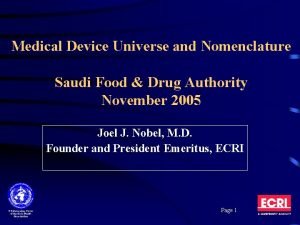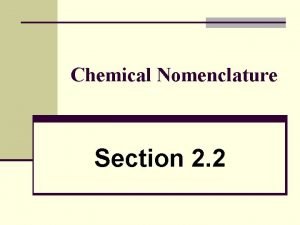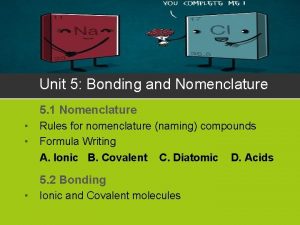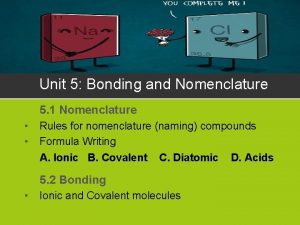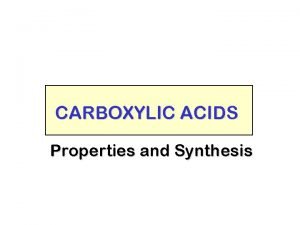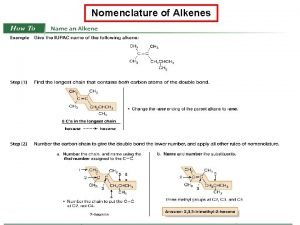Unit 05 Nomenclature Nomenclature is the system used




















- Slides: 20

Unit 05 Nomenclature

Nomenclature is the system used for naming substances Names are important……

Symbols • Each element has a symbol displayed on the periodic table. • Some elements have a symbol that is a single letter while others have a symbol made up of two letters. • It is important when writing the two letter symbols to ensure that you use a lower case letter for the send letter • This may sound trivial but is very important, for example, Co (cobalt), a metal element, is not the same as CO (carbon monoxide), a gaseous compound made from carbon (C) and oxygen (O).

Binary compounds of metals and non-metals (ionic compounds) • Binary compounds are those formed between only two elements. • In compounds where one is a metal one a non-metal an ionic compound is formed. • An ion is a charged particle and ionic formulae and names can be determined by considering the charge on the ions. • To find the formula of an ionic compound the positive and negative charges must be balanced, i. e. , there must be no net charge • To name a binary compound of a metal and non-metal, the unmodified name of the positive ion is written first followed by the root of the negative ions with the ending modified to –ide. • Example, Na. Cl is Sodium Chloride

Negative ions (ANIONS) Positive Ions (CATIONS) NAME CHARGE SYMBOL Bromide 1 - Br- Aluminum 3+ Al 3+ Chloride 1 - Cl- Barium 2+ Ba 2+ Fluoride 1 - F- Calcium 2+ Hydride 1 - H- Copper (I) Iodide 1 - I- Nitride 3 - Oxide Positive Ions (CATIONS) NAME CHARGE SYMBOL Ca 2+ Manganese (II) 2+ Mn 2+ 1+ Cu 1+ Nickel (II) 2+ Ni 2+ Copper (II) 2+ Cu 2+ Potassium 1+ K 1+ N 3 - Hydrogen 1+ H 1+ Silver 1+ Ag 1+ 2 - O 2 - Iron (II) 2+ Fe 2+ Sodium 1+ Na 1+ Phosphide 3 - P 3 - Iron (III) 3+ Fe 3+ Strontium 2+ Sr 2+ Sulfide 2 - S 2 - Lead (II) 2+ Pb 2+ Tin (II) 2+ Sn 2+ Lead (IV) 4+ Pb 4+ Tin (IV) 4+ Sn 4+ Lithium 1+ Pb 1+ Zinc 2+ Zn 2+ Magnesium 2+ Pb 2+ Most transition metal ions (and a few other metal ions) include a Roman numberal after the name, for example, copper (II). These metals form ions with varying charges, and the Roman numberal identifies the charge in each case. Elements that commonly form an ion with only a single charge for example, sodium, do not have Roman numberal associated with them.

Check up 05 a • Name these binary compounds • • Na. Cl Sr. O Al. N Ba. Cl 2 K 2 O Cu 2 O

Check up 05 a • Convert these names to formulae. • • Magnesium nitride Barium bromide Aluminum phosphide Potassium iodide Lithium chloride Sodium fluoride Tin (IV) bromide

Binary acids • Acids will be discussed at great length later in the course, but for the purposes of nomenclature, and acid can be defined as a compound that produces hydrogen ions (H+) when it is dissolved in water, and the formulae of acids start with ‘H’. • Binary acids are formed when hydrogen ions combine with monatomic anions. • To name a binary acids use the prefix ‘hydro’ followed by the other non-metal name modified to an –ic ending. Then add the word ‘acid’. • For example, HCl is hydrochloric acid.

Polyatomic ions • Polyatomic ions are those where more than one element are combined together to creat a species with a charge. • Some of these ions can be named systematically, others names must be learned. • Some common polyatomic ions, their charges and formulae are listed on the next page.

Common Polyatomic Ions Name Charge Formula Ammonium 1+ NH 4+ Carbonate 2 - CO 32 - Chromate (VI) 2 - Cr. O 42 - Dichromate (VI) 2 - Cr 2 O 72 - Ethanedioate 2 - C 2 O 42 - Hydrogen carbonate 1 - HCO 3 - Hydrogen sulfate 1 - HSO 4 - Hydroxide 1 - OH- Manganate (VII) (Permanganate) 1 - Mn. O 4 - Nitrate 1 - NO 3 - Nitrite 1 - NO 2 - Phosphate 3 - PO 43 - Sulfate 2 - SO 42 - Sulfite 2 - SO 32 -

Polyatomic ions • Polyatomic anions where oxygen is combined with another non-metal are called oxoanions and can be named systematically. • In these oxoanions certain non-metals (CL, N, P and S) form a series of oxoanions containing different numbers of oxygen atoms. • Their names are related to the number of oxygen atoms present, and are based upon the system below. Name Number of oxygen atoms Hypo(element)ite 1 (Element)ite 2 (Element)ate 3 Per (element)ate 4

Oxoanions • Where there are only two members in such a series the endings are –ite and –ate. • Example sulfite (SO 32 -) and sulfate (SO 42 -). • When there are four members in the series the hypo- and per- prefixes are used additionally. • Some Oxoanions contain hydrogen and are named accordingly, for example, HPO 42 -, hydrogen phosphate. The prefix this- means that a sulfur atom has replaced an atom of oxygen in an anion. • To name an ionic compound that contains a polyatomic ion, the unmodified name of the positive ions is written first followed by unmodified name of the negative ion. For example, K 2 CO 3 is potassium carbonate.

Oxoacids • Oxoacids are formed when hydrogen ions combine with polyatomic oxoanions. • This gives a combination of hydrogen, oxygen and another non-metal • To name an oxoacid use the name of the oxoanions and replace the –ite ending with –ous or the ate ending with –ic. Then add the word ’acid’. For example, H 2 SO 4 is sulfuric acid. • To illustrate the names of these oxoanions and oxoacids consider the following example using chlorine as the non-metal. Formula and name of oxoacid Formula and name of corresponding oxoanion HCl. O Hypochlorous acid Cl. O- Hypochlorite HCl. O 2 Chlorous acid Cl. O 2 - Chlorite HCl. O 3 Chloric Acid Cl. O 3 - Chlorate HCl. O 4 Perchloric acid Cl. O 4 - Perchlorate

Checkup 05 b • What are the formulae fo the following ionic compounds? • • Ammonium nitrate Copper (II) bromide Copper (I) bromide Zinc hydrogen sulfate Aluminum sulfate Sodium perchlorate Copper (II) iodite

Checkup 05 b • Convert the following formulae to names • • Na. NO 3 KMn. O 4 Ca. C 2 O 4 Cu. SO 4 Cu 2 SO 4 KNO 2 Li. Cl. O 4

Binary compounds of two non-metals (molecular compounds) • If the two elements in a binary compound are non-metals, then the compound is molecular • To name a molecular compound of two non-melt as, the unmodified name of the first element is followed by the root of the second element with ending modified to –ide. • In order to distinguish between several different compounds with the same elements present use the prefixes mono, di, Tri, tetra, penta and hexa to represent one, two, three, four, five, and six atoms of the element respectively. • Example, SO 2 is sulfur dioxide

Binary compounds of two non-metals Formula Name BCl 3 Boron trichloride CCl 4 Carbon tetrachloride CO Carbon monoxide CO 2 Carbon dioxide NO Nitrogen monoxide NO 2 Nitrogen dioxide Note that the prefix mono is only applied to the second element present in such compounds, if the prefix ends with ‘a’ or ‘o’, and the element name begins with ‘a’ or ‘o’, then the final vowel of the prefix is often omitted Some compounds have trivial names that have come to supersede their systematic names, for example, H 2 O is usually. ‘Water’, not dihydrogen monoxide

Checkup 05 c • Write formula or names for the following molecular compounds • • • Dinitrogen tetroxide Phosphorous pentachloride Iodine trifluoride Nitrogen dioxide Dihydrogen monoxide

Checkup 05 c • Convert the following formulae to names • • • N 2 O 5 PCl 3 SF 6 H 2 O Cl 2 O

Hydrates • Hydrates are ionic formula units with water molecules associated with them. • The water molecules are incorporated into the solid structure of the ions. • Strong heating can generally drive off the water in these salts. • Once the water has been removed the salts are said to be anhydrous (without water). • To name a hydrate use the normal name of the ionic compound followed by the term ‘hydrate’ with an appropriate prefix to show the number of water molecules per ionic formula unit. • Example, Cu. SO 4 -5 H 2 O is Copper (II) sulfate pentahydrate
 Unit 10, unit 10 review tests, unit 10 general test
Unit 10, unit 10 review tests, unit 10 general test Ecri umdns
Ecri umdns Outline the binomial system of nomenclature
Outline the binomial system of nomenclature Hát kết hợp bộ gõ cơ thể
Hát kết hợp bộ gõ cơ thể Ng-html
Ng-html Bổ thể
Bổ thể Tỉ lệ cơ thể trẻ em
Tỉ lệ cơ thể trẻ em Gấu đi như thế nào
Gấu đi như thế nào Chụp tư thế worms-breton
Chụp tư thế worms-breton Hát lên người ơi
Hát lên người ơi Các môn thể thao bắt đầu bằng tiếng bóng
Các môn thể thao bắt đầu bằng tiếng bóng Thế nào là hệ số cao nhất
Thế nào là hệ số cao nhất Các châu lục và đại dương trên thế giới
Các châu lục và đại dương trên thế giới Công thức tiính động năng
Công thức tiính động năng Trời xanh đây là của chúng ta thể thơ
Trời xanh đây là của chúng ta thể thơ Cách giải mật thư tọa độ
Cách giải mật thư tọa độ Làm thế nào để 102-1=99
Làm thế nào để 102-1=99 độ dài liên kết
độ dài liên kết Các châu lục và đại dương trên thế giới
Các châu lục và đại dương trên thế giới Thơ thất ngôn tứ tuyệt đường luật
Thơ thất ngôn tứ tuyệt đường luật Quá trình desamine hóa có thể tạo ra
Quá trình desamine hóa có thể tạo ra

